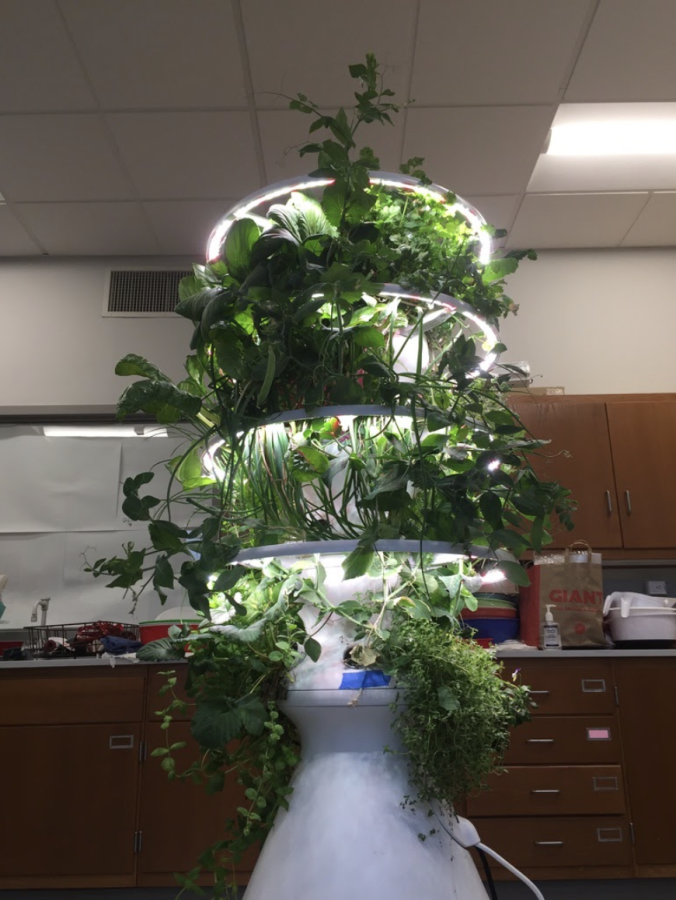So What Is That Plant Thing Anyway?
December 5, 2021
The “plant thing” you might have seen on display in the school gallery is called the farmstand. The farmstand is a self-watering, self-fertilizing, hydroponic growing system produced by the company, Lettuce Grow. Since most people do not know what hydroponic means, Merriam-Webster dictionary defines hydroponic growing as the growing of plants in nutrient solutions with or without an inert medium such as soil.
So, how does the farmstand work? The farmstand comes disassembled, so the first step is to construct it. Mr. Charriez, MS science teacher, and Levi Sawdon ’28 built the farmstand at school. “It’s pretty straightforward to build it. I want to say it only took us about 15 minutes to assemble it,” said Mr. Charriez. Step two is to fill the base of the farmstand with water and insert the seedlings into the pods. The farmstand we have at school has four tiers with six pods on each tier making a total of 24 pods for growing plants. Step three is just to hook the farmstand up to an outlet and let it do its magic. It’s as easy as that! Once the farmstand gets set up it does most of the work for you. A pump at the base of the farmstand, where the water is stored, pushes water to the top of the tower which then filters back down to the reservoir at the base, watering the pods along the way. Glow lights on the exterior act as artificial sunlight which keeps the seedlings growing at a healthy rate. “The seedlings are pretty small when you get them, but over the course of a few weeks they’ll grow into edible human-sized plants that you can snip and eat and make salads with,” said Charriez.
So, how did the school come to acquire an 800 dollar indoor gardening system? Friends was awarded a Garden Grant from Whole Foods for $3000 so that they could purchase a greenhouse. As part of that grant, Whole Foods partnered with Lettuce Grow to give out lettuce grow systems to schools that wanted them. When Charriez heard about this opportunity, he quickly registered for a farmstand. Whole Foods donated the farmstand, and the school bought the glow rings for an additional $300.
So far this year, MS science classes have used the farmstand to grow a large assortment of fruits and vegetables including strawberries, cherry tomatoes, kale, spinach, sugar snap peas, and several different types of lettuce. They have also grown some herbs such as chives, thyme, mint, and cilantro as well as some flowers.
After talking to Mr. Charriez and a handful of middle school students, it seems like the farmstand has been a big hit. Charriez also commented, “We’ve been using the plants we’ve grown in our farmstand in some of our cooking lessons in science class. Last week, for example, we made kale smoothies using kale we harvested right from the Lettuce Grow tower!”
Finally, when asked whether the school should invest in more sustainable options in the future, Mr. Charriez said, “Absolutely, I think having a few of these in the building would make a statement for a couple of reasons. Number one, the tower is made of recycled plastic found in the ocean. Number two, I think nutrition and teaching healthy eating should be part of what we do at this school so having these around the school might encourage people to think twice about their food choices at school and maybe give salad greens another look.” Levi Sawdon ’28 replied, “It would be great if WFS had more farm stands so that we could sustainably grow and eat food in our cafeteria even in the winter. We could also donate extra food that we grow to those in need in our community.” The farmstand has been a huge success so far and with more sustainable systems such as this, there is potential for the school to reduce its carbon footprint and support our community.































